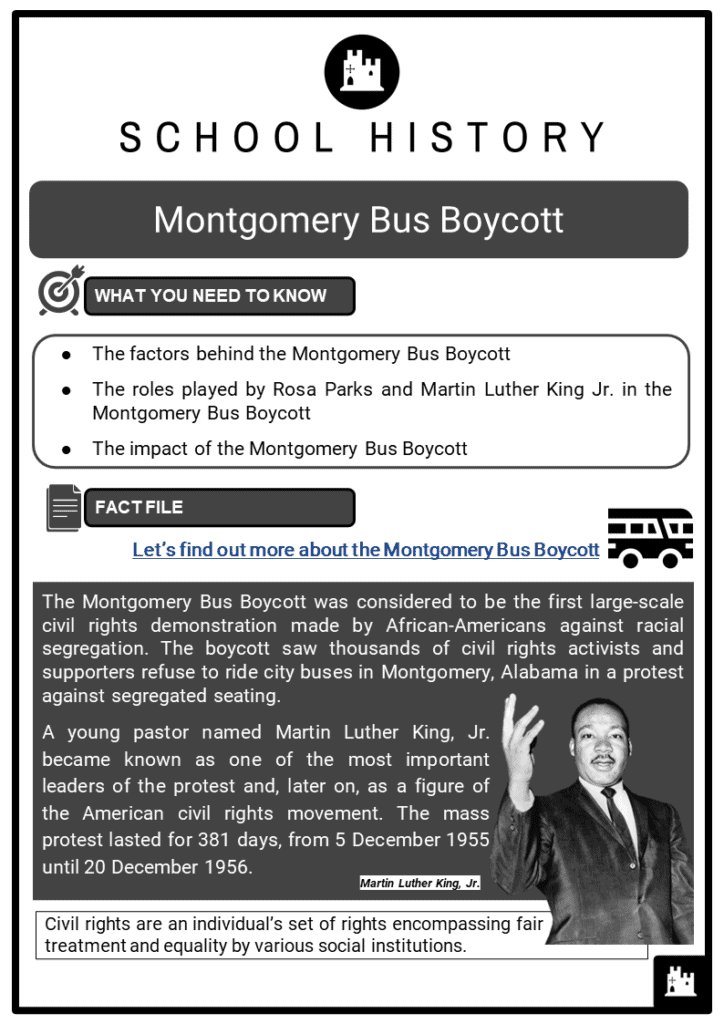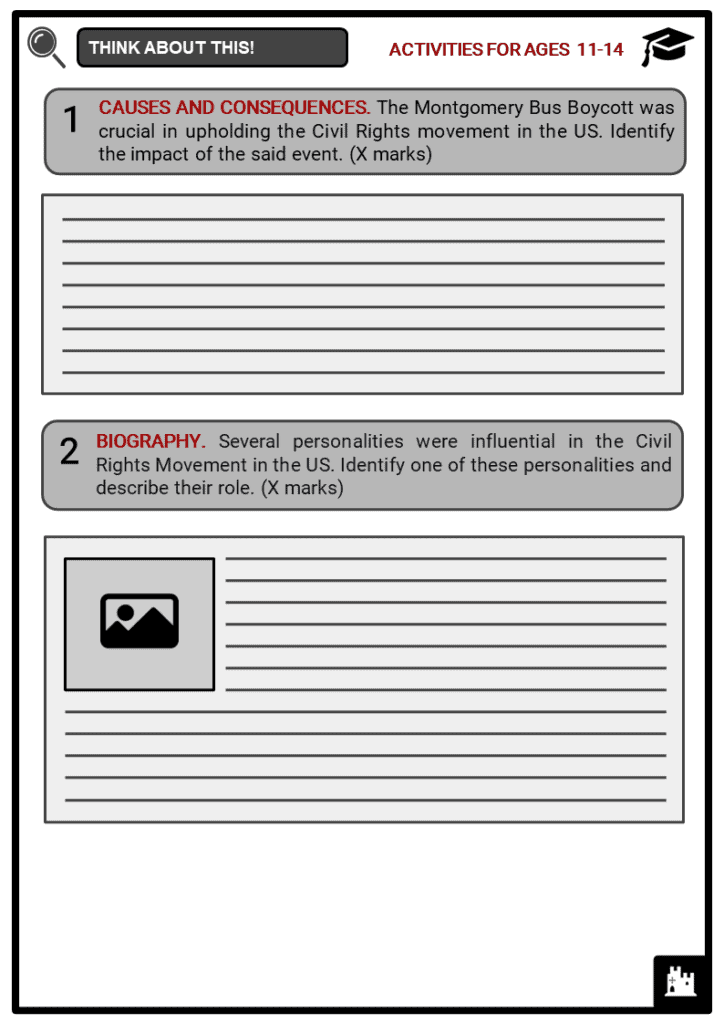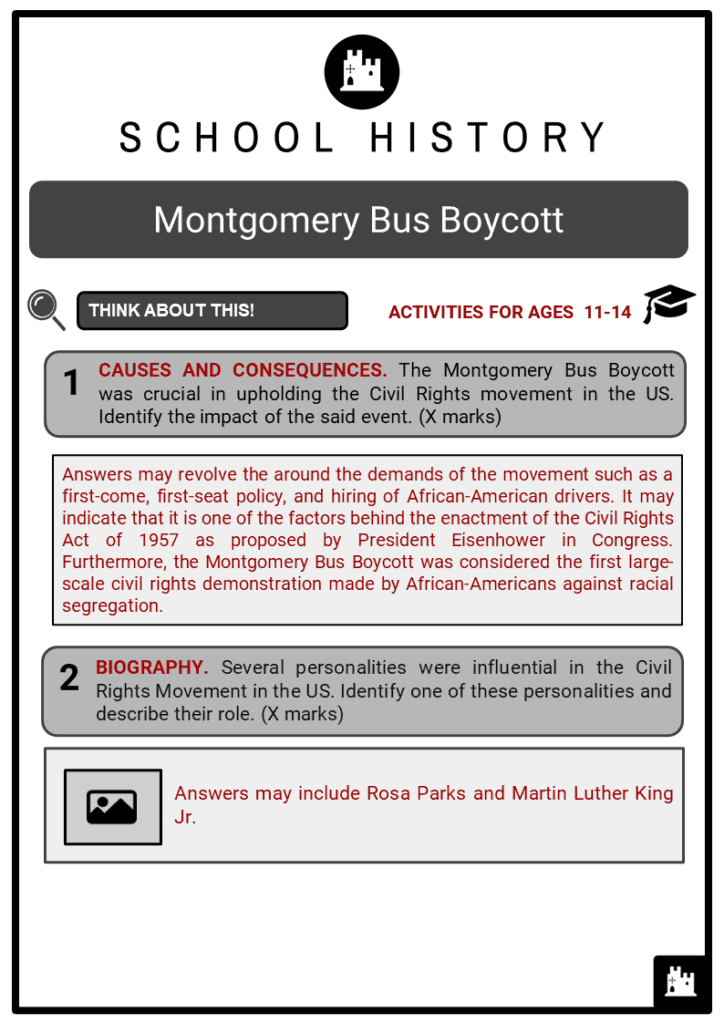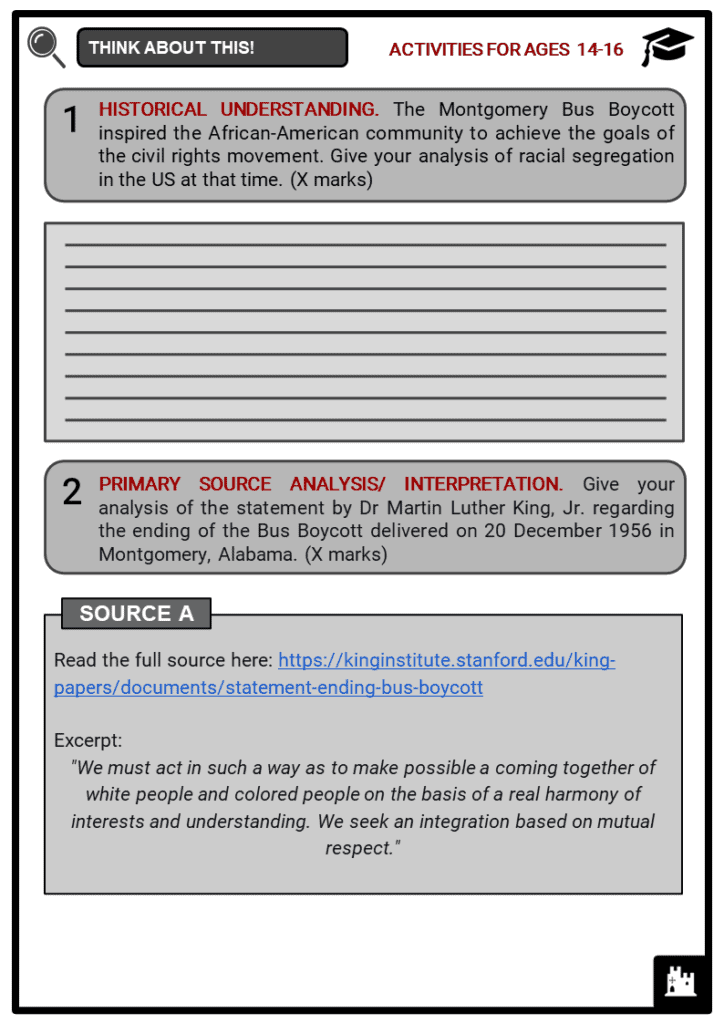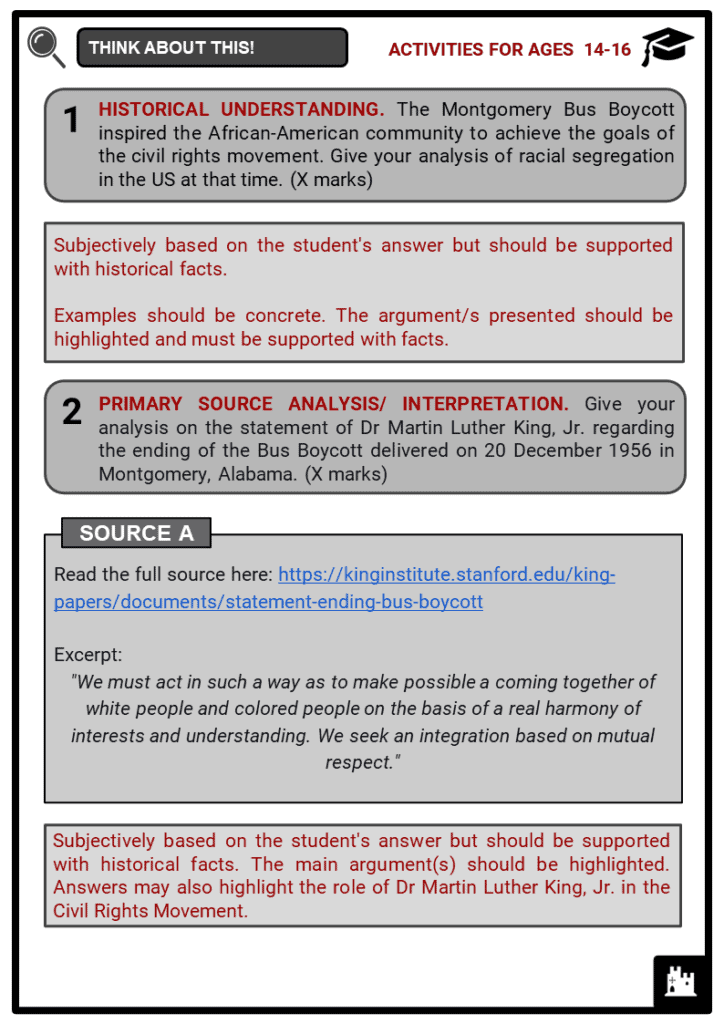Download Montgomery Bus Boycott Worksheets
Do you want to save dozens of hours in time? Get your evenings and weekends back? Be able to teach Montgomery Bus Boycott to your students?
Our worksheet bundle includes a fact file and printable worksheets and student activities. Perfect for both the classroom and homeschooling!
Table of Contents
Add a header to begin generating the table of contents
Summary
- The factors behind the Montgomery Bus Boycott
- The roles played by Rosa Parks and Martin Luther King Jr. in the Montgomery Bus Boycott
- The impact of the Montgomery Bus Boycott
Key Facts And Information
Let’s find out more about the Montgomery Bus Boycott
- The Montgomery Bus Boycott was considered to be the first large-scale civil rights demonstration made by African-Americans against racial segregation. The boycott saw thousands of civil rights activists and supporters refuse to ride city buses in Montgomery, Alabama in a protest against segregated seating.
- A young pastor named Martin Luther King, Jr. became known as one of the most important leaders of the protest and, later on, as a figure of the American civil rights movement. The mass protest lasted for 381 days, from 5 December 1955 until 20 December 1956.
- Civil rights are an individual’s set of rights encompassing fair treatment and equality by various social institutions.
Racial Segregation
- Before the boycott happened, racial segregation had been present in the United States for a very long time, particularly in the Southern States. African-Americans were discriminated against for being black.
- Racial segregation was mandated by the Jim Crow laws, creating a division between white Americans and black Americans in many public spaces, such as schools, transportation, restrooms, and restaurants. An example of this segregation was evident in the existence of “for whites only” or “for coloureds only” signs.
- The Jim Crow policies were named after "Jump Jim Crow", a song and dance popularised in 1832 featuring a black male caricature performed by a white actor, Thomas D. Rice.
- The policies not only legalised racial segregation, but also denied African-American people many democratic rights, including the right to vote, education, and employment.
- The Jim Crow policy as adopted by the city buses of Montgomery was challenged by the establishment of the Women’s Political Council (WPC) in 1946.
- In 1954, WPC members held a meeting with the city mayor as they called to end the racist seating practices of Montgomery buses for African-American people. They demanded that the African-American community be allowed to buy bus tickets for front seats, not just in the back. WPC also asked that no black person should be left standing beside an empty seat. However, their demands were not heard.
Rosa Parks incident
- On 1 December 1955, exactly four days before the boycott, an African-American woman, Rosa Parks, who was riding a bus on Montgomery’s Cleveland Avenue from her work as a seamstress at a local department store, was arrested and fined 10 USD as she refused to give her front-row seat to a white man.
- The incident occurred when the 'white section' of the bus was full and the driver, James F. Blake, ordered African-Americans in the front row to vacate their seats. Parks refused and she was arrested and fined 10 USD plus 4 USD for court fees.
- Prior to this, Parks had already had an encounter with Blake wherein she’d paid her bus fare at the front of the bus then exited it to re-enter through the back door, but Blake pulled away before she could board.
- Even before this event, Claudette Colvin (then a fifteen-year-old student) and Mary Louise Smith (then eighteen years old), were also arrested for not following the bus practices.
- Parks, together with her husband Raymond, were active members of a local chapter of the National Association for the Advancement of Colored People (NAACP). Following the Parks incident, WPC members began mobilising the African-American people community, calling for a boycott of the Montgomery city buses. They distributed flyers and leaflets to reach all African-Americans to challenge the city ordinance.
- The boycott, which was organized by WPC President Jo Ann Robinson, gained the attention of the media, attracting more publicity. It was even advertised through the local newspaper, the Montgomery Advertiser.
The Boycott
- As the boycott continued to circulate in the media, landing on the front page of the Montgomery Advertiser, a general-interest newspaper, African-American leaders in Montgomery voiced their support. Black ministers also encouraged more supporters in church.
- On 5 December 1955, an estimate of 40,000 African-American bus riders responded to the boycott. That same afternoon, African-American leaders held a meeting to establish the Montgomery Improvement Association (MIA), during which Martin Luther King, Jr. was elected as the president. King Jr. was a young pastor of Montgomery’s Dexter Avenue Baptist Church.
- On the evening of the boycott, the protesters decided to extend the mass demonstration. At first, they tried talking to city commissioners and bus companies to lay their demands, including the first-come first-seated policy, courtesy from bus drivers, and hiring of African-American drivers. However, their attempts were unsuccessful.
- To ensure that the boycott would continue, African-American leaders organised carpools. Other African-Americans decided to ride bicycles or walked to work. African-American taxi drivers charged only 10 cents, the same rate as city buses, for African-American commuters. The boycott leaders likewise organised the African-Americans in order to gain more support.
- However, protesters were harassed in the streets. African-American drivers who charged lower rates were fined by the city.
- By 5 June 1956, a Montgomery federal court declared that any policies concerning racial segregation in city buses were against the law. The 14th Amendment of the US Constitution stated that all citizens regardless of race should receive equal rights and protection.
- Following this, an appeal was filed by the city, but the US Supreme Court affirmed the decision of the lower court, therefore declaring racial segregation as unconstitutional on 20 December 1956, which also happened to be the last day of the boycott.
Aftermath
- Even after the integration, a number of white people refused to co-operate. Segregated bus stops in Montgomery were still maintained.
- In 1957, incidents of violence were recorded, led by the white supremacist group, the Ku Klux Klan, who bombed African-American churches and the homes of known African-American leaders, including that of Martin Luther King, Jr.’s.
- The Ku Klux Klan was radical with their campaigns, which involved attacks and killings of African-Americans. They were known for their signature long white robe, mask, and hood.
- The boycott sparked more mobilisations and demonstrations, which contributed to the American civil rights movement. King Jr. continued to lead large-scale protests, gaining international attention.
- On 9 September 1957, the Civil Rights Act of 1957 was enacted, as proposed by President Eisenhower in Congress signifying support of the national government for racial equality. Moreover, in 1965, the Voting Rights Act was passed, allowing African-American citizens to vote and participate in politics.
- Rosa Parks likewise remained a prominent figure in the civil rights movement, even writing a book about it. The actual bus where Parks sat was displayed at the Henry Ford Museum in Michigan.
Image sources:
- https://upload.wikimedia.org/wikipedia/commons/8/84/Martin_Luther_King_Jr_NYWTS.jpg
- https://upload.wikimedia.org/wikipedia/commons/5/50/Rosa_Parks_being_fingerprinted_by_Deputy_Sheriff_D.H._Lackey_after_being_arrested_for_boycotting_public_transportation_-_Original.jpg
- https://www.blackpast.org/african-american-history/montgomery-bus-boycott-1955-56/

